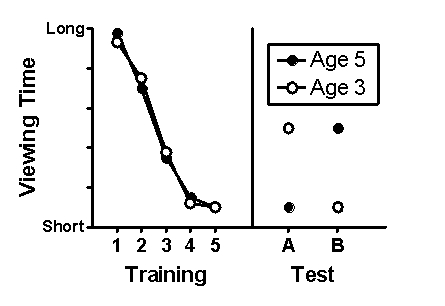Scenario I
Scenario I is based on and presents fabricated results consistent with the following study:
Kim, I. K., & Spelke, E. S. (1992) . Infants' sensitivity to effects of gravity on visual object motion. Journal of Experimental Psychology: Human Perception and Performance, 18(2) , 385-393.
Kim and Spelke (1992) investigated the extent to which infants have expectancies of gravitational effects on visual object motion. Three- and five-month-old infants repeatedly watched a video of a ball accelerating as it rolled down an incline until they spent little time actively looking at it. Subsequently, two types of test trials were conducted in randomized order. Type A test trials consisted of a ball slowing down as it rolled up an incline. Type B test trials consisted of a ball slowing down as it rolled down an incline. During all trials, the amount of time looking at each visual display was recorded. Fabricated data consistent with the major finding of this study are presented in Figure 11.1.
Figure 11.1 
-(Scenario I) Which is a true inference based on the data shown in Figure 11.1?
A) Three-month-olds were more easily surprised by the test trials than five-month olds.
B) Throughout the experiment, five-month-olds exhibited greater attention spans than three-month-olds.
C) Test trials revealed that five-month-olds, but not three-month-olds, developed object permanence to the ball.
D) Three-month-olds were more attracted to the novel features of the test stimuli than five-months-olds.
Correct Answer:
Verified
Q2: Use the following to answer questions
Scenario
Q4: Scenario II
Scenario II is based on the
Q4: Use the following to answer questions
Scenario
Q5: Scenario II
Scenario II is based on the
Q7: Scenario I
Scenario I is based on and
Q7: Use the following to answer questions
Scenario
Q8: Scenario I
Scenario I is based on and
Q9: Scenario II
Scenario II is based on the
Q10: Use the following to answer questions
Scenario
Q13: Scenario II
Scenario II is based on the
Unlock this Answer For Free Now!
View this answer and more for free by performing one of the following actions

Scan the QR code to install the App and get 2 free unlocks

Unlock quizzes for free by uploading documents